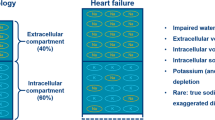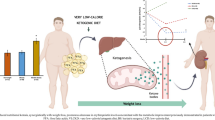Abstract
The need to optimise nutrition to promote growth in infants with chronic renal insufficiency (CRI) is well recognised, but there is less enthusiasm for such an approach in older children and those with milder degrees of CRI. Energy intakes and growth outcomes were prospectively monitored over a 2-year period in children aged 2–16 years with differing levels of severity of CRI, as part of their ongoing joint medical/ dietetic care. Children were grouped following [51Cr]-labelled EDTA glomerular filtration rate (GFR, ml/min per 1.73 m2) estimations, into ‘normal’ kidney function [GFR >75, mean 106 (SD 19.5), n =58], providing baseline data only, mild (GFR 51–75, n =25), moderate (GFR 25–50, n =21), and severe (GFR <25, n=19) CRI. Children were followed for 2 years, with 51 completing the study (19 mild, 19 moderate, 13 severe CRI), and were excluded if they required dialysis. None received growth hormone. Regular dietary advice was provided and yearly 3-day semi-quantitative dietary diaries and baseline and 6-monthly anthropometric measurements were obtained. Mean height standard deviation score (SDS) was maintained in those with mild and moderate CRI and significantly increased in children with severe CRI [0.1 SDS (0.32 SD), F =9.45, 1 df, P =0.003]. There was a non-significant reduction in energy intake from dietary records overall (median −8.5% estimated average requirement), associated with poor adherence to supplements in severe CRI and under-reporting in the mild group. An increase in height or body mass index SDS, however, was observed in all children who took the supplements as prescribed. A correlation between change in energy intake and change in height SDS was observed in severe CRI ( r 2=0.58, P =0.011). Regular dietetic advice, with particular attention to adherence to optimise energy intake, may improve growth, irrespective of age and should form an integral part of the clinical care package.


Similar content being viewed by others
References
Chantler C, Holliday MA (1973) Growth in children with renal disease with particular reference to the effects of calorie malnutrition: a review. Clin Nephrol 1:230–242
Claris-Appiani A, Ardissino GL, Dacco V, Funari C, Terzi F (1995) Catch-up growth in children with chronic renal failure treated with long-term enteral nutrition. J Parent Ent Nutr 19:175–178
Norman LJ, Evans JC (1998) Chronic renal failure in infancy. Two dietetic case reports. EDTNA/ERCA J 24:6–9
Kari JA, Gonzalez C, Ledermann SE, Shaw V, Rees L (2000) Outcome and growth of infants with severe chronic renal failure. Kidney Int 57:1681–1687
Wingen A-M, Mehls O (2002). Nutrition in children with preterminal chronic renal failure. Myth or important therapeutic aid? Pediatr Nephrol 17:111–120
Arnold WC, Danford D, Holliday MA (1983) Effects of caloric supplementation on growth in children with uremia. Kidney Int 24:205–209
Foreman JW, Abitbol CL, Trachtman H, Garin EH, Feld LG, Strife F, Massie MD, Boyle RM, Chan JCM (1996) Nutritional intake in children with renal insufficiency: A report of the Growth Failure in Children with Renal Diseases study. J Am Coll Nutr 15:579–585
Hellerstein S, Holliday MA, Grupe WE, Fine RN, Fennell RS, Chesney RW, Chan JCM (1987) Nutritional management of children with chronic renal failure: summary of the task force on nutritional management of children with chronic renal failure. Pediatr Nephrol 1:195–211
Norman LJ, Coleman JE, Macdonald IA, Tomsett AM, Watson AR (2000) Nutrition and growth in relation to severity of renal disease in children. Pediatr Nephrol 15:259–265
Fivush BA, Jabs K, Neu AM, Sullivan EK, Feld LG, Kohaut E, Fine R (1998) Chronic renal insufficiency in children and adolescents: the 1996 annual report of NAPRTCS. Pediatr Nephrol 12:328–337
Cole TJ, Freeman JV, Preece MA (1995) Body mass index reference curves for the UK, 1990. Arch Dis Child 73:25–29
Freeman JV, Cole TJ, Chinn S, Jones PRM, White EM, Preece MA (1995) Cross-sectional stature and weight reference curves for the UK, 1990. Arch Dis Child 73:17–24
Nelson M, Nettleton PA (1980) Dietary survey methods—a semi-weighed technique for measuring dietary intake within families. J Hum Nutr 34:325–348
DoH (Department of Health) (1991) Dietary reference values for food energy and nutrients for the United Kingdom. HMSO, London
Torun B, Davies PSW, Livingstone MBE, Paolisso M, Sackett R, Spurr GB (1996) Energy requirements and dietary energy recommendations for children and adolescents 1 to 18 years old. Eur J Clin Nutr 50:S37–S81
Schofield WN (1985) Predicting basal metabolic rate, new standards and review of previous work. Hum Nutr Clin Nutr 39C [Suppl 1]:5–41
Schaefer F, Seidel C, Binding A, Gasser T, Prader A, Scharer K (1990) Pubertal growth in chronic renal failure. Pediatr Res 28:5–10
Black AE, Cole TJ (2001) Biased over- or under-reporting is characteristic of individuals whether over time or by different assessment methods. J Am Diet Assoc 101:70–80
NKF-K/DOQI (National Kidney Foundation Dialysis Outcomes Quality Initiative (2000) Clinical practice guidelines for nutrition in chronic renal failure. Am J Kidney Dis 35
Abitbol CL, Chan JCM, Trachtman H, Strauss J, Greifer I (1996) Growth in children with moderate renal insufficiency: measurement, evaluation and treatment. J Pediatr 129:S3–S8
Watson AR, Coleman JE, Warady BA (1998) When and how to use nasogastric and gastrostomy feeding for nutritional support. In: Fine RN, Alexander SR, Warady BA (eds) CAPD/CCPD in children, 2nd edn. Kluwer, Boston, pp 281–301
Dickinson D, Wilkie P, Harris M (1999) Taking medicines: concordance is not compliance. BMJ 319:787
Acknowledgement
We would like to thank Dr. Sarah Lewis, Senior Lecturer in Medical Statistics, Division of Respiratory Medicine at Nottingham City Hospital for her review of the statistical methods used in this study.
Author information
Authors and Affiliations
Corresponding author
Rights and permissions
About this article
Cite this article
Norman, L.J., Macdonald, I.A. & Watson, A.R. Optimising nutrition in chronic renal insufficiency—growth. Pediatr Nephrol 19, 1245–1252 (2004). https://doi.org/10.1007/s00467-004-1580-3
Received:
Revised:
Accepted:
Published:
Issue Date:
DOI: https://doi.org/10.1007/s00467-004-1580-3




